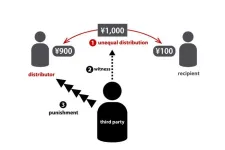(Press-News.org) A large proportion of babies born very early need intensive care, which can be painful. But the healthcare system fails to provide pain relief to the full extent. This is shown by the largest survey to date of pain in neonatal care, now published in the journal Pain.
Every day for 4.5 years, neonatal care staff have recorded the occurrence of pain, the causes of pain, and how pain is assessed and treated in premature babies in Sweden. The study covers 3,686 babies born between 22 and 31 weeks of gestation from 2020 to 2024. The total observation time was just over 185,000 days of care. Data were collected in the Swedish Neonatal Quality register.
In the evaluation of the register data, the researchers found that babies born extremely early, in weeks 22 to 23, had the highest proportion of painful medical conditions and almost daily painful intensive care procedures throughout the first month after birth. However, this is not surprising.
“There is a strong correlation between acute morbidity and being born very early. The earlier a baby is born, the more intensive care it needs. Intensive care involves procedures that can be painful, such as ventilator treatment, tube feeding, insertion of catheters into blood vessels and surgical procedures. It also requires various tests and investigations that may involve pain,” says Mikael Norman, professor of paediatrics at the Department of Clinical Science, Intervention and Technology, Karolinska Institutet, and lead researcher of the study.
90 percent of the most extremely preterm infants had to undergo painful procedures. Despite this, healthcare professionals reported that only 45 percent of babies experienced pain - which may be because pain was largely prevented or treated. However, a check of the drugs administered suggests other explanations may exist.
“Somewhat surprisingly, the smallest babies who were most exposed to pain had the lowest proportion of treatment with morphine. This may be a case of undertreatment,” says Mikael Norman.
One limitation is that the study could not determine the duration or severity of pain for each day reported.
“The caregivers only answered yes or no to the question of whether the infant had experienced any pain in the last 24 hours. This could range from short-term, so-called procedural pain from for example a needle prick during a test to more continuous pain due to various medical conditions.
“Much is done to alleviate pain in babies. No child in neonatal care is left with severe pain untreated,” he continues.
However, it is a problem and a challenge that healthcare professionals are not always able to determine whether children are in pain.
“This involves developing better rating scales or physiological techniques to measure pain . Better pain treatments are also needed, perhaps with combinations of drugs with less risk of side effects,” says Dr Norman.
It is very important to improve pain management for premature babies, as we now know that their development is negatively affected by the strong signals in the brain that pain causes.
“The vision for all neonatal care is to be pain-free. The results of this survey will be of great importance for improving neonatal care and for future research in the field,” concludes Mikael Norman.
The research was mainly funded by Region Stockholm, the Childhood Foundation of the Swedish Freemasons in Stockholm, and the Swedish Research Council.
Facts:
Pain in newborns is not self-reported as in older children and adults. To objectively assess the presence of pain in newborns, healthcare professionals use different pain scales instead. The scales are based on recording the baby's breathing, facial expressions, movements, and comfortability. However, very premature babies show less evidence of pain than babies born at term, such as only frowning or moving less.
In morphine treatment, there is a fine line between pain relief and a drop in blood pressure, which is a side effect. Very premature babies already have very low blood pressure and crossing this line can lead to circulatory collapse, which can be very serious. This is probably one reason why the very young babies were given less morphine than perhaps they should have been given, given the high proportion in pain.
Source: Mikael Norman.
Publication: “Pain in very preterm infants - prevalence, causes, assessment and treatment. A nationwide cohort study”, Graham H, Razaz N, Håkansson S, Thernström Blomqvist Y, Johansson K, Persson M, Nyholm A, Norman M, Pain, online 27 January 2025, doi: 10.1097/j.pain.0000000000003528
END
Preterm babies receive insufficient pain management
2025-01-27
ELSE PRESS RELEASES FROM THIS DATE:
Does historic redlining—a form of structural racism—affect survival in young people with cancer?
2025-01-27
A recent study indicates that children and young adults with cancer face an elevated risk of dying if they live in previously redlined neighborhoods—residential areas marked in the 1920s–1930s by lenders as undesirable for mortgage loans due to their racial demographics. The findings are published by Wiley online in CANCER, a peer-reviewed journal of the American Cancer Society.
Historic redlining prevented Black households and other communities of color from accessing home mortgages for many years, leading to economic disadvantage and racial ...
How animal poop helps ecosystems adapt to climate change
2025-01-27
Climate change is melting away glaciers around the world, but in the Andes Mountains, a wild relative of the llama is helping local ecosystems adapt to these changes by dropping big piles of dung.
This finding, published Dec 30 in Scientific Reports, revealed that the activity of this animal could accelerate the time plants usually take to establish on new land by over a century, highlighting a surprising way organisms are adapting to climate change.
“It’s interesting to see how a social behavior of these animals ...
Over 1/3 of parents say their child has experienced dental problems that reflect oral hygiene habits
2025-01-27
More than one in three parents say their child has faced issues like tooth decay, cavities, stained teeth, gum concerns or tooth pain over the past two years, a national poll suggests.
And these problems were linked to children’s oral care routine, more commonly experienced among those who skipped dental hygiene recommendations or followed them less often, according to the University of Michigan Health C.S. Mott Children’s Hospital National Poll on Children’s Health.
“Maintaining oral health from a young age, including regular brushing ...
Colorado’s parental notification law can impede adolescent access to abortion, study says
2025-01-27
AURORA, Colo. (Jan. 27, 2025) – A new study led by researchers from the University of Colorado Anschutz Medical Campus has shed light on the burdens parental involvement laws impose on adolescents seeking abortion care, even in states like Colorado where abortion is protected. Researchers say these laws contribute to logistical barriers, heightened stress and delays in accessing care, disproportionately impacting vulnerable populations.
The study, published today in the Journal of Adolescent Health, analyzed the experiences of adolescents (ages 15-17) and young adults (18-22) who either sought or ...
Drones could be the ‘magic tools’ we need to chase bears away from people
2025-01-27
Brown bears roam across much of the northern hemisphere from the mountains of Spain to the prairies of the US. These bears are formidable carnivores that can weigh up to 751 kg (1,656 lb) and have claws 15 cm (6 in) long. With long canine teeth and a bite force of 6,800,000 pascals (1,000 psi), these bruins can easily crush bones. All these powerful features make brown bears an imposing predator that can take down prey as large and dangerous as an adult bison. Yet, while these bears eat meat, much of their diet is plant-based because they are omnivores. Brown bears have very few dietary restrictions. They are certainly not gluten intolerant ...
Rethinking altruistic punishment: New experimental insights
2025-01-27
How would you react if someone cut in line behind you? Some people will warn others to follow the rules, even if it does not affect them. This is known as altruistic punishment, the act of punishing others for selfish behavior without reciprocal benefit.
Previous studies on altruistic punishment often placed participants in unnatural settings where they were compelled to observe the selfishness of others and decided whether to punish them. In reality, there are times when avoidance of such a situation takes precedence over confronting unfairness. In other words, a person could pretend they did ...
Move more, age well: Prescribing physical activity for older adults as a recipe for healthy aging
2025-01-27
Can physical activity extend the lifespans of older adults? A review article published in CMAJ (Canadian Medical Association Journal) https://www.cmaj.ca/lookup/doi/10.1503/cmaj.231336 summarizes the considerable evidence supporting the important role physical activity plays in preventing or reducing the effects of diseases and discusses how to prescribe effective exercise for older adults.
Canada’s population is aging, with at least 1 in 5 people aged 65 years or older in 2025, and the number of people older than age 85 years is expected to triple in the next 20 years. However, for many people, ...
Botanic Gardens must team up to save wild plants from extinction
2025-01-27
A major study of botanic gardens around the world has revealed their struggles with one fundamental aim: to safeguard the world’s most threatened plants from extinction.
Researchers analysed a century’s worth of records - from 1921 to 2021 - from fifty botanic gardens and arboreta currently growing half a million plants, to see how the world’s living plant collections have changed over time.
The results suggest that the world’s living collections have collectively reached peak capacity, and that restrictions ...
Approaching the red planet from the kitchen
2025-01-27
Niigata, Japan - Rootless cones are small volcanic landforms ranging from several to several hundred meters in diameter, formed by continuous explosions resulting from the interaction between surface lava and water bodies like lakes and rivers (Figure 1). Unlike regular volcanoes originating from magma rising from deep underground, rootless cones form when lava covers a water-containing layer, triggering explosive reactions. Due to this process, they are also called pseudocraters. While Iceland hosts many rootless cones, they ...
How Camellias evolved with the formation of the Japanese archipelago?
2025-01-27
Niigata, Japan – The distribution of plants has been shaped by geological and climatic changes over time through repeated migration, extinction, and adaptation to new environments. The genus Camellia, comprising over 100 species mainly in East Asia, is a representative warm-temperate tree of the Sino-Japanese Floristic Region.
In Japan, four species of Camellia are found, with Camellia japonica and Camellia rusticana being the most well known. C. japonica has a broad distribution from Aomori Prefecture in the cool-temperate ...






